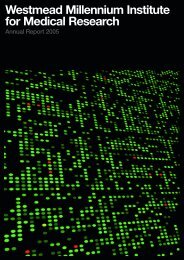Translating >> - Westmead Millennium Institute
Translating >> - Westmead Millennium Institute
Translating >> - Westmead Millennium Institute
You also want an ePaper? Increase the reach of your titles
YUMPU automatically turns print PDFs into web optimized ePapers that Google loves.
40 41 > Research Report // AR 2006<br />
specific proteins in the cell, with emphasis on cellular<br />
and to improve our understanding of the mechanisms that<br />
clinical outcome and, eventually, improve the survival of<br />
disease in patients with haematological malignancy.<br />
alterations that lead to breast and colon cancer. The group<br />
is investigating how such mutations disrupt the normal<br />
function of the BRCA1 protein.<br />
determine how a patient will respond to chemotherapy.<br />
The normal process of ovulation is known to play a part<br />
in early events leading to ovarian cancer. The Group has<br />
patients with ovarian cancer. In all, more than 1800 patients<br />
have been recruited to the study, surpassing expectations and<br />
data analysis is underway.<br />
In the last 12 months, the group has continued to develop<br />
its clinical program of cytomegalovirus (CMV) specific<br />
cytotoxic T cell administration to patients with impaired<br />
The BRCA1 protein senses DNA damage. It monitors<br />
dividing cells, and in response to DNA damage, initiates<br />
gene repair processes in the cell nucleus so the errors are not<br />
transmitted to new cells. BRCA1 has a partner, BARD1;<br />
their interaction helps facilitate the DNA-repair process.<br />
Previously the group discovered that the BRCA1 and<br />
BARD1 proteins, in their unbound state, are normally free to<br />
shuttle between the nucleus and cytoplasm, but when bound<br />
together they become confined to the nucleus, an essential<br />
step in activating the complexed proteins for their crucial role<br />
in DNA-repair and cell-survival.<br />
They have also identified a class of BRCA1 gene mutations<br />
that display an unexpected influence on the BRCA1 proteins<br />
that carry this mutation. The mutant BRCA1 proteins are<br />
positioned differently inside the cell, and are prevented from<br />
entering the nucleus and complexing with BARD1. This<br />
finding provides another mechanism for changes in DNA<br />
repair elicited by BRCA1 gene mutations in breast cancer.<br />
In 2006 the laboratory discovered that the BARD1 protein<br />
locates at cellular mitochondria, implicating a pathway for<br />
control of cell death or cell survival.<br />
The group is also investigating two genes that appear to<br />
play key roles in colorectal cancer: beta catenin and the<br />
tumour-suppressor gene APC. A very large protein, APC<br />
- like BRCA1 - shuttles between the cytoplasm and the<br />
nucleus, where it performs its tumour-suppressor function.<br />
The ultimate aim of this research is to discover new pathways<br />
that control the action of proteins like BRCA1 and APC<br />
in normal cells, and to develop drugs or other reagents that<br />
correct defects in these pathways in cancer cells.<br />
Gynaecological cancers<br />
Ovarian cancer is the most lethal gynaecological malignancy.<br />
The Gynaecological Cancer Research Group has a program<br />
of research which aims to improve our understanding of the<br />
progression from healthy ovarian epithelial cells to cancer<br />
used laser capture micro-dissection to dissect out individual<br />
epithelial cells from normal ovaries, to studying normal<br />
patterns of gene expression during the ovulatory cycle, using<br />
mice as a model system. They used expression microarrays<br />
to identify all active genes in normal cells, and then use<br />
changing patterns of normal gene expression as a standard to<br />
detect aberrant gene expression patterns in malignant human<br />
ovarian cells. Genes that normally regulate cell proliferation<br />
and apoptosis (programmed cell death) are obvious suspects<br />
for contributing to malignant transformation. The group has<br />
identified several novel candidate genes that may be involved<br />
in the initial steps leading to ovarian cancer.<br />
Most ovarian cancers are initially sensitive to chemotherapy,<br />
but eventually develop resistance. Currently there was no<br />
way to predict which ovarian cancers would become resistant<br />
to chemotherapy, nor any way to modulate gene expression<br />
to restore drug sensitivity. The group has identified a set of<br />
genes whose expression levels differ between resistant and<br />
drug-sensitive cells. They have found that one of these genes<br />
is higher in tumours from patients that have a worse clinical<br />
outcome. The <strong>Institute</strong> has a patent on the discovery, and is<br />
now seeking compounds to reduce expression of this gene,<br />
that could be used in combination with platinum drugs to<br />
treat ovarian cancer.<br />
The Australian Ovarian Cancer Study is a major<br />
collaborative project involving WICR, the Queensland<br />
<strong>Institute</strong> of Medical Research (QIMR), and Melbourne’s<br />
Peter McCallum Cancer Centre (PeterMac), and over 20<br />
hospitals across the country. It aimed to recruit 1000 ovarian<br />
cancer patients and create a library of biospecimens at the<br />
PeterMac, for analysis to identify genes involved in ovarian<br />
cancer. QIMR researchers have collected comprehensive<br />
epidemiological data on patients to help identify<br />
environmental and life-style risk factors, while the WICR<br />
group are monitoring the individual patients for a minimum<br />
of five years, recording all details of their treatment and its<br />
outcome. The data will be correlated with risk-factor data<br />
and tumour-gene profiles to identify factors that will predict<br />
Leukaemia cell biology group<br />
The Leukaemia Cell Biology Group is investigating the<br />
role of bone marrow stromal cells in acute lymphoblastic<br />
leukaemia (ALL). ALL is the most common childhood<br />
cancer. Although responsive to chemotherapy 25% of<br />
children and 65% of adults will relapse following treatment<br />
and less than 10% of relapsed patients will survive for 5 years.<br />
New treatments for ALL are necessary to improve outcomes<br />
for these patients.<br />
ALL arises in the bone marrow from cells that normally<br />
develop into B cells (antibody producing cells). ALL cells<br />
are highly dependent on the bone marrow stroma for their<br />
growth and survival and bone marrow stroma protects ALL<br />
cells from the effects of chemotherapy. The leukaemia cell<br />
biology group has been investigating ways in which the bone<br />
marrow supports ALL cells with the aim of disrupting this<br />
supportive and protective function.<br />
The group has identified SDF-1 as a major factor that<br />
supports ALL cells. Drugs that can block the effects of SDF-<br />
1 move ALL cells out of the bone marrow making them<br />
more susceptible to chemotherapy. These drugs inhibit the<br />
growth of ALL cells in the laboratory and in a mouse model<br />
of human leukaemia. These drugs were particularly effective<br />
at minimizing the spread of ALL to other tissues including<br />
the liver and kidney.<br />
The group has also studied the way in which SDF-1<br />
tells ALL cells to grow and survive. By targeting these<br />
mechanisms, even more potent agents have been identified.<br />
It is anticipated that these drugs will enhance the effectiveness<br />
of currently used chemotherapy agents with minimal toxicity.<br />
If successful, these agents will decrease the total dose of<br />
chemotherapy required to treat standard risk patients and<br />
help increase the cure rates in patients with a poor prognosis.<br />
Leukaemia cell therapies<br />
The Cell Therapies group focuses on investigating the use of<br />
targeted cells for the treatment of infectious and malignant<br />
immune systems. The group is currently running its<br />
second clinical trial of CMV specific T cell administration<br />
for patients recovering after allogeneic bone marrow<br />
transplantation. The initial trial using a CMV peptide to<br />
stimulate donor T cells accrued 9 patients. No acute adverse<br />
events were observed and increases in CMV specific T cells<br />
in circulation following infusion were observed. No patient<br />
in the trial required pharmacotherapy for CMV infection or<br />
reactivation.<br />
A considerable amount of effort has been expended in the<br />
last 12 months on gaining approval for a gene therapy trial<br />
of CMV that will expand entry criteria into the trial and will<br />
result in a broader target specificity of CMV antigens. The<br />
trial commenced accrual late in 2006 and has already accrued<br />
8 patients with 4 patients receiving T cell infusions from<br />
their donors. No adverse events have been noted and no<br />
pharmacotherapy for CMV has been required as yet in any<br />
patient receiving T cells.<br />
We are also studying the generation in vitro of T cells<br />
specific for the viral illness varicella zoster that commonly<br />
affect immunocompromised individuals. Using a clinical<br />
vaccine preparation for antigen stimulation, the group has<br />
been able to stimulate growth of a population of T cells<br />
whose specificity is currently being assessed. It is hoped that<br />
this process can be incorporated into generation of CMV<br />
specific T cells to give a tri-virus specific culture product that<br />
will recognise CMV, adenovirus (derived from the vector<br />
encoding the CMV protein pp65) and varicella zoster virus.<br />
Translational oncology<br />
The aim of the Translational Oncology group is to focus<br />
research on clinically important issues in oncology and to<br />
assist clinical application of basic laboratory research through<br />
examination of information and samples from patients with<br />
cancer.<br />
In 2006, the group continued to work to identify measures<br />
that may assist determination of optimal chemotherapy










